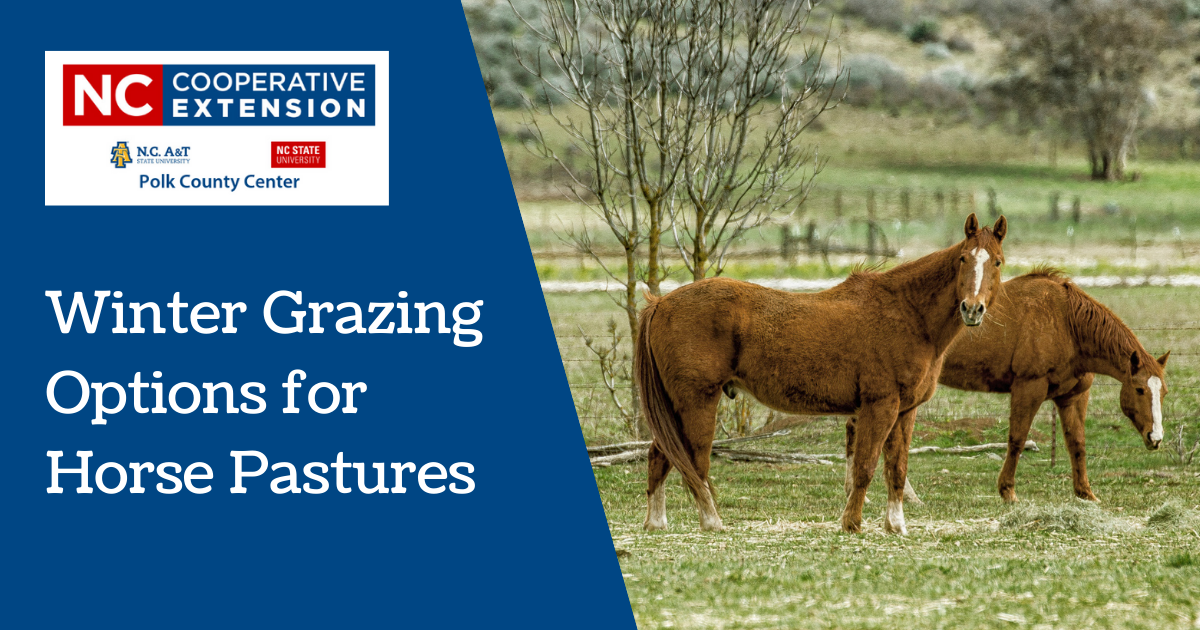Winter Grazing Options for Horse Pastures
go.ncsu.edu/readext?824334
en Español / em Português
El inglés es el idioma de control de esta página. En la medida en que haya algún conflicto entre la traducción al inglés y la traducción, el inglés prevalece.
Al hacer clic en el enlace de traducción se activa un servicio de traducción gratuito para convertir la página al español. Al igual que con cualquier traducción por Internet, la conversión no es sensible al contexto y puede que no traduzca el texto en su significado original. NC State Extension no garantiza la exactitud del texto traducido. Por favor, tenga en cuenta que algunas aplicaciones y/o servicios pueden no funcionar como se espera cuando se traducen.
Português
Inglês é o idioma de controle desta página. Na medida que haja algum conflito entre o texto original em Inglês e a tradução, o Inglês prevalece.
Ao clicar no link de tradução, um serviço gratuito de tradução será ativado para converter a página para o Português. Como em qualquer tradução pela internet, a conversão não é sensivel ao contexto e pode não ocorrer a tradução para o significado orginal. O serviço de Extensão da Carolina do Norte (NC State Extension) não garante a exatidão do texto traduzido. Por favor, observe que algumas funções ou serviços podem não funcionar como esperado após a tradução.
English
English is the controlling language of this page. To the extent there is any conflict between the English text and the translation, English controls.
Clicking on the translation link activates a free translation service to convert the page to Spanish. As with any Internet translation, the conversion is not context-sensitive and may not translate the text to its original meaning. NC State Extension does not guarantee the accuracy of the translated text. Please note that some applications and/or services may not function as expected when translated.
Collapse ▲Fall is the perfect time for planting winter annuals such as annual ryegrass, oats, wheat or cereal rye in your pastures for grazing; however, the term “winter” can be misleading. Although these annuals remain green and nutritive throughout the winter, their most prolific growth actually occurs in the spring (April-May). In a warm season perennial pasture (Bermuda or Bahia) that goes dormant in the winter, these annuals provide the opportunity for green pastures through the winter and some winter grazing. The amount of winter grazing, though, is highly dependent on how early they are planted in the fall as well as growth conditions such as adequate rainfall. Removing horses from the seeded pastures to allow for adequate growth through the fall is also recommended if the goal is truly to have a winter forage.
Depending on your grazing needs, oats can be planted earlier and are the best option if fall grazing is desired. Keep in mind that this plant is also the least cold-tolerant and can experience some winter kill. Ryegrass is the easiest to establish and can be broadcast with good success, whereas others are better established by drilling into the existing sod. Ryegrass is highly preferred by horses and also tolerates grazing better than some of the other annual options. For those concerned about non-structural carbohydrates, however, annual ryegrass may have the potential to accumulate more stored sugars than other annual forage species. Cereal rye (rye grain) is very cold tolerant, but is also the least preferred by horses in grazing trials. This may allow for some consistent growth without completely removing horses from the pasture.
For those of us with predominately fescue pastures, planting these annuals is not recommended because of the competition it creates in the spring. Winter annuals have the same active growing season as our cool season perennials, fescue and orchardgrass, but are much more prolific in the spring, often weakening perennial forage stands. Don’t let this be a discouragement though. Fescue can actually be the best winter grazing option that we have. When fertilized in the fall and if grazing pressure is deferred, fescue can act as a standing hay crop to be grazed through winter (termed “stockpiling“). Unlike in spring, fall fescue growth remains vegetative and leafy, maintaining forage quality even as cooler temperatures slow growth. Utilizing grazing techniques such as strip grazing, the fescue pasture can then be rationed out in small sections to stretch the grazing season. Depending on acreage available, hay feeding can be drastically reduced or even completely deferred until January.
Although our climate provides great growing conditions for a variety of forage options much of the year, most all pastures will experience a slump in growth from late January through early March even if you have a stockpile or planted winter annuals. If you have fescue pastures, now is a great time to fertilize with 40 to 60 pounds of nitrogen (if phosphorous and potassium are adequate) and section off a portion to stockpile for early winter. If you don’t have fescue, there are many winter annual options that can help fill some gaps in late fall and early spring. If you have questions about which option may be the best for your farm, please contact me at the Extension office for a free on-farm consultation.





